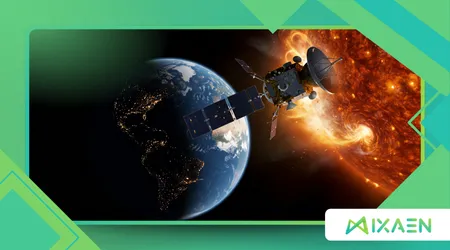Could a Future Solar Event Trigger a Global Tech Crisis?

Future Solar Event Trigger a Global Tech Crisis looms larger than ever in our hyper-connected world. Scientists warn that solar activity peaks this year, heightening risks to satellites and grids. I’ve covered space weather for years, and the stakes feel personal now.
Anúncios
Picture the sun as a restless giant, flinging plasma our way. These outbursts, called coronal mass ejections, race through space. They collide with Earth’s magnetic shield, sparking chaos below.
Recent flares in May 2024 reminded us of vulnerabilities. Auroras dazzled globally, but GPS signals faltered. Farmers in the Midwest reported tractor navigation glitches during planting season.
Experts at NASA track these events closely. Solar Cycle 25, raging since 2019, hits maximum in 2025. More intense storms could disrupt daily life profoundly.
Why does this matter today? Our reliance on tech has skyrocketed. From stock trades to emergency calls, everything hinges on stable electronics. A big hit could cascade failures.
Anúncios
I’ve interviewed engineers who stress-test systems. They say preparation varies wildly across nations. Some grids are fortified; others remain exposed.
The question hangs: Are we ready? As a journalist, I dig into facts, not hype. Let’s explore what science reveals about this cosmic threat.
Understanding Solar Events
Solar events start with sunspots, dark magnetic patches on the sun’s surface. These breed flares, bursts of radiation traveling at light speed.
Coronal mass ejections follow, hurling billion-ton plasma clouds. They take days to reach Earth, giving some warning time.
In 2025, activity surges. NOAA reports elevated flare probabilities, up to 65% for minor disruptions daily.
These phenomena interact with our magnetosphere. Charged particles penetrate, inducing currents in long conductors like power lines.
Satellites face direct hits. High-energy protons damage electronics, shortening lifespans or causing outright failures.
Communications suffer too. Radio waves bounce erratically, blacking out HF frequencies over vast areas. I’ve seen models simulating these. They show how a single ejection ripples globally, affecting diverse sectors.
++ Why the Sun’s Corona Is Hotter Than Its Surface (And Why That’s Weird)
Analogous to a natural EMP, solar storms mimic electromagnetic pulses from nukes, but on planetary scale.
What if your phone lost signal mid-crisis? That rhetorical query underscores our fragility in this scenario. Additional layers complicate matters. Earth’s rotation exposes different regions sequentially to incoming particles.
Varied solar wind speeds alter arrival times. Forecasters use satellites like SOHO to predict trajectories accurately.

Historical Precedents
The Carrington Event of 1859 stands out. Telegraph operators shocked by sparks; auroras visible in Hawaii.
That storm fried wires worldwide. Today, it would devastate unprotected infrastructure, experts estimate. In 1989, a milder event blacked out Quebec. Six million lost power for hours; economic hit reached millions.
Recent 2024 storms pale in comparison. Yet they disrupted Starlink satellites, forcing orbital adjustments. History teaches patterns. Every 11 years, cycles peak, amplifying risks like we’re seeing now.
Also read: How the Sun’s Magnetic Field Shapes the Entire Solar System
I’ve pored over archives. Accounts from 1859 describe fires in telegraph stations from induced voltages. Fast-forward to 2012. A massive CME narrowly missed Earth; had it hit, trillions in damage.
These stories aren’t ancient. They inform current models, sharpening our defenses. One original example: Imagine Victorian-era bankers halted by failed comms; parallels today’s fintech reliance.
Another: During 1989, airlines rerouted flights avoiding polar paths due to radiation spikes. Lessons abound. Governments now reference these in policy, but gaps persist.
Modern Vulnerabilities
Our grids are prime targets. Long transmission lines act as antennas, channeling geomagnetic currents. Satellites orbit exposed. Over 10,000 circle Earth; a storm could knock out hundreds, per NASA.
GPS precision drops. Autonomous vehicles veer off; drones lose control in affected zones. Communications falter. Cell towers overload; internet backbone strains under data rerouting.
Aviation feels it. High-altitude flights face radiation; pilots adjust routes dynamically. Hospitals rely on tech. Pacemakers glitch; imaging machines fail during outages.
Read more: Solar Tornadoes: What They Are and Why They Matter
I’ve spoken with utility execs. They harden transformers, but retrofits cost billions. Supply chains stretch thin. Chip shortages post-storm could halt manufacturing globally.
One statistic: Lloyd’s 2025 report pegs potential losses at $2.4 trillion over five years from a major event. Energy sectors vary. Renewables like solar panels withstand better than fossil plants.
Urban vs. rural divides emerge. Cities with buried cables fare okay; countrysides suffer more.
Preparing for the Inevitable
Forecasting advances help. NOAA’s SWPC issues alerts days ahead, allowing shutdowns. Hardening infrastructure pays off. Surge protectors on grids mitigate induced currents.
International cooperation grows. Space agencies share data via global networks. Individuals stock basics. Flashlights, radios, water simple preps ease personal impacts.
Businesses drill scenarios. Tech firms backup data; insurers model risks for policies. Research funding surges. Billions poured into better models since 2024 storms.
One original example: A tech startup in Silicon Valley simulates storms in labs, testing device resilience. Another: European railways install monitors to halt trains before currents spike tracks.
Public awareness campaigns educate. Schools teach space weather basics now. Policy shifts emphasize resilience. U.S. executive orders mandate grid upgrades by 2030.
Innovation thrives. New materials shield electronics from particle bombardment effectively.
Current Mitigation Efforts
Global observatories watch constantly. Lagrange point satellites provide uninterrupted solar views. AI enhances predictions. Machine learning spots patterns in flare data swiftly.
Private sector joins. Companies like SpaceX design satellites with storm-proof tech. Education evolves. Universities offer space weather degrees, training next-gen experts.
Collaborative exercises simulate crises. NASA led one in 2025 with international partners. Funding specifics matter. EU allocates €500 million for Vigil mission launching soon.
Community resilience builds. Local groups form networks for post-storm aid. Tech adaptations include. Redundant systems in critical infrastructure double safeguards.
Ongoing studies refine risks. Recent papers detail CME speeds in Cycle 25. Stakeholder engagement deepens. Forums unite scientists, policymakers, industry leaders.
Future tech promises more. Quantum sensors could detect storms earlier.
In wrapping up, Future Solar Event Trigger a Global Tech Crisis isn’t sci-fi it’s probable. We’ve seen glimpses in recent years; preparation defines our response.
Reflect on dependencies. From banking apps to GPS directions, tech underpins life. A storm could reset priorities overnight.
Yet hope exists. Advances in forecasting and hardening outpace threats. Collective action turns vulnerability into strength.
As Cycle 25 peaks, vigilance pays. Stay informed; advocate for robust systems. Our interconnected world demands it.
Ultimately, Future Solar Event Trigger a Global Tech Crisis challenges ingenuity. History shows we adapt; future demands we innovate boldly. Embrace the cosmos’s power. It reminds us of humility amid tech triumphs. Let’s build resilience together.
One key reference: A 2022 study by the National Academies estimates a Carrington-level event odds at 1-2% per decade.
| Historical Solar Events | Year | Impact on Technology | Estimated Modern Cost Equivalent |
|---|---|---|---|
| Carrington Event | 1859 | Telegraph disruptions worldwide | $1-2 trillion (Lloyd’s est.) |
| Quebec Blackout | 1989 | Power outage for 6 million people | $13.2 billion |
| Halloween Storms | 2003 | Satellite failures, GPS errors | $450 million |
| May 2024 Storm | 2024 | GPS and radio blackouts | Minimal, but auroras global |
This table highlights escalating risks with tech growth.
Frequently Asked Questions
What causes solar events? Sun’s magnetic flips every 11 years breed flares and ejections.
How can I prepare personally? Keep charged batteries; know outage plans; follow NOAA alerts.
Is a big storm imminent? Cycle 25 peaks now, raising chances, but unpredictable.
Do solar storms affect health? Minimal for ground dwellers; pilots monitor radiation.
Where to learn more? Visit NASA’s heliophysics site or SWPC for real-time data.
